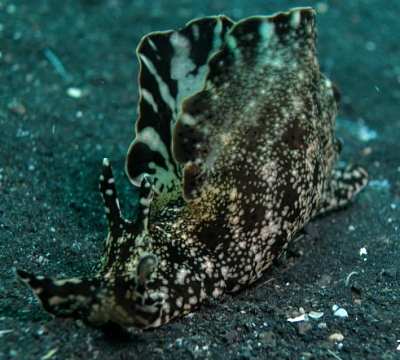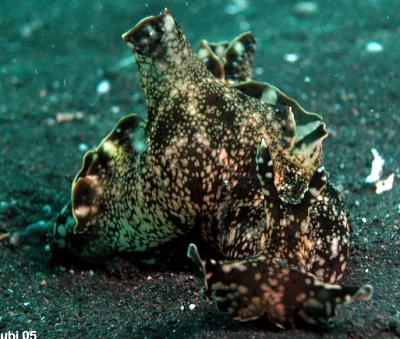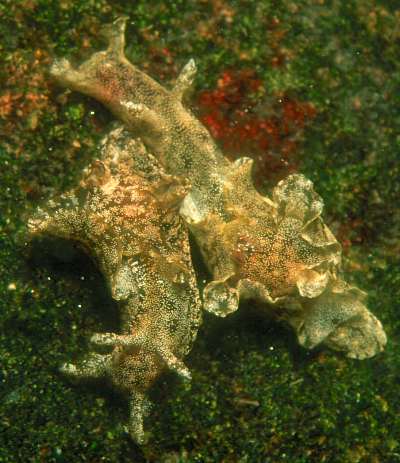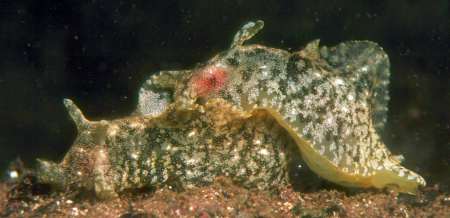
Aplysia oculifera
(Adams & Reeve, 1850)
Order: ANASPIDEA
Superfamily: APLYSIOIDEA
Family: Aplysiidae
DISTRIBUTION
Indo-West Pacific.
PHOTO
Shimoda, Izu Peninsula, Sagami Bay , Japan, Intertidal, 15 Dec 2001. Upper Photo: about 80mm long., Lower photo: about 60mm long. Photos: Jun Imamoto.
This species is characterised by the small brown eye-spots all over the head and parapodia.
References:
• Bebbington, A. (1974) Aplysiid species from East Africa with notes on the Indian Ocean Aplysiomorpha (Gastropoda: Opisthobranchia). Zoological Journal of the Linnean Society, 54: 63-99.
•Bebbington, A. (1977) Aplysiid species from Eastern Australia with notes on the Pacific Ocean Aplysiomorpha (Gastropoda: Opisthobranchia). Transactions of the Zoological Society of London, 34: 87-147.
See Larval development page


Rudman, W.B., 2000 (May 25) Aplysia oculifera (Adams & Reeve, 1850). [In] Sea Slug Forum. Australian Museum, Sydney. Available from http://www.seaslugforum.net/find/aplyocul
Related messages
Aplysia oculifera from Kerala, India
September 7, 2009
From: Dr. A. Biju Kumar


Dear Bill:
I am attaching photographs of some Aplysia that we collected from the southwest coast of India.
We think the upper one is Aplysia oculifera. Kindly confirm the identification. As the shallow rocky pool areas of southwest coast of India are not surveyed seriously for associated biodiversity, there are possibilities of finding new distribution records from this region. We are currently working on preparing a marine biodiversity database for Kerala State of India.Upper & Lower Photos: Five specimens were collected from among the sea weeds attached to rock. Locality: Arabian Sea/Indian Ocean; Kovalam (Lat. 80 05' N; Long. 770 15' E), Thiruvananthapuram district, Kerala State, India. Habitat: Rock in the intertidal area. Size: 2.4 - 5.1 cm. Date: 11 July 2009. Middle Photo: One specimen was collected attached to sea weed.
Locality: Arabian Sea/Indian Ocean; Vizhinjam (Lat. 80 22' N; Long. 760 57' E) Thiruvananthapuram district, Kerala State, India. Habitat: Rocky intertidal pool. Size: 2.3 cm. 18 August 2009. Photos: A. Biju Kumar
Thanking you
Sincerely,
Biju
Dept. of Aquatic Biology & Fisheries
University of Kerala,
Thiruvananthapuram
Kerala, INDIA
bijupuzhayoram@gmail.com
Kumar, B., 2009 (Sep 7) Aplysia oculifera from Kerala, India. [Message in] Sea Slug Forum. Australian Museum, Sydney. Available from http://www.seaslugforum.net/find/22651
Dear Biju,
These are all Aplysia oculifera. The name 'oculifera' means 'bearing eyes' which refers to the small black rings which could be compared with eyes. In the close-up alongside, the true left eye is not the black-ringed white spot behind the left head tentacle [rhinophore] but the black spot which I have ringed with white.
Best wishes,
Bill Rudman
Aplysia? from Ratnagiri, India
March 11, 2009
From: Vishal J. Bhave.

Dear Bill,
I observed about 5 of these Sea Hares in a shallow rock pool. The rock pool had a dense cover of Padina vegetation.
One pair was observed mating.
Locality: Alawa, Mirya, Ratnagiri, 0.5 feet, Maharashtra, India, Arabian Sea / Indian ocean, 25 January 2009, Rock pool, rocky substratum, Intertidal,. Length: 6-8 cm. Photographer: Vishal Bhave.
Vishal Bhave
vishalbhave@gmail.com



Dear Vishal,
I am pretty sure these are Aplysia oculifera. You will see from other photos on the Forum that this species usually has small brown 'eye rings' [which give it the name oculifera] but in your specimens they are just small brown spots. However each brown spot is sitting on a translucent brown patch, which is just the same as the brown rings in more typical A. oculifera. That species often has quite a dense covering of small white spots. Although not as plentiful in your animals, you can certainly see them in your photos. The animals is your lower photo certainly appear to be mating
Best wishes,
Bill Rudman
Aplysia kurodai ? in Indonesia
July 3, 2008
From: Teresa Zuberbühler

Concerning message #17917:
Dear Bill
I saw in the forum, you have the distribution of Aplysia kurodai only in Japan, Korea and China. I saw this sea hare which I belive is the same species in Sulawesi, Indonesia.
Locality: Lembeh, 10-15m, Sulawesi, Indonesia, Pacific, 28. March 2005, black sand. Length: 6-7cm. Photographer: Teresa (Zubi) Zuberbühler.
Best wishes
Teresa Zubi
webmaster@starfish.ch



Dear Zubi,
I suspect there are more names for sea hares than actual species. Most species have been named from one or a very few animals from a single location which doesn't allow for very much colour variation which we know occurs in these animals. If we look at photos of Aplysia dactylomela on the Forum we find a range from animals with very large open rings to others with small rings [see #20921] which could almost be identified as A. oculifera.
As I discuss in other places on the Forum, Aplysia kurodai was not very well described and as there are many species with a colour pattern of brown and white mottling. From photos I have seen it seems that what is called A. kurodai in Japan is a swimming species with relatively thin parapodia. Your photos seem to be of animal with thicker more rigid parapodial flaps - more like A. dactylomela and A. oculifera. Also the colour pattern of dark and light bands on the inside of the parapodia is also more similar to A. dactylomela and A. oculifera. The scattered brown patches on the parapodia, which I have ringed, remind me of the brown background for the eyespots in A. oculifera. I suspect your animals are a colour form of A. oculifera, or even A. dactylomela.
Best wishes,
Bill Rudman
Re: Feeding studies on Aplysia in Malaysia
July 21, 2007
From: Corvin Eidens


Concerning message #20022:
I contacted Prof. Klussmann-Kolb and she identified one of the sea hares (Aplysia dactylomela) and maybe the other one is Aplysia oculifera. I think there is also a third species.
I will attach some more pics.
Corvin Eidens
corvin@eidens.de
Eidens, C., 2007 (Jul 21) Re: Feeding studies on Aplysia in Malaysia. [Message in] Sea Slug Forum. Australian Museum, Sydney. Available from http://www.seaslugforum.net/find/20261
Dear Corvin,
Your message arrived after I had posted my comments on #20249. I'm glad my identification coincided with Annette Klussmann-Kolb's. I assume the three photos you attached represent the three supposed species. If so the top one is A. dactylomela and the bottom one - just the head - is A. oculifera. This leaves the middle one - the mating pair - as unidentified. I think at this stage it would be useful if you could send photos of these three 'species' as separate messages. It would be useful if you could include a juvenile and adult photo if you have them, and a side shot so we can see how far back the parapodia go.
The problem is that Aplysia taxonomy is in a mess - especially in the Indo-West Pacific. As I have said before, most species were described from preserved specimens and so fitting the descriptions to living aniamls has never been satisfactorily resolved. The only attempt at a world-wide revision (Eales, 1960) is based almost entirely on preserved specimens, and extremely difficult to use for species identification.
It's possible the animals in your middle photo are a form of A. dactylomela without rings. I know you study is not centred on the animals, but I suspect you are the only one who is going to be able to sort out how many species of Aplysia you have. All I can say is see who mates with whom. That is a pretty fundamental distinction. You will also see that different species have differences in shape and relative size of the parapodia - and the parapodia join differntly at the posterior ends in different species. In A. dactylomela the parapodia join quite high just behind the mantle cavity, while in A. oculifera they stay separate almost to the posterior tip of the tail. How does your third species compare? There will also be differences in shape of oral tentacles and rhinophores, and thickness and feel of the skin - and parapodial flaps. These differences are much easier to see in living animals.
Even if we can't put a name on your third species - if there is a third species - at least you will know you are dealing with three not two species.
Good Luck,
Bill Rudman
Re: Feeding studies on Aplysia in Malaysia
June 29, 2007
From: Corvin Eidens
Concerning message #20022:
Well the big bright one is around 10 cm long and the darker ones only ca. 3 cm...
Locality: Rocky shore north of Kuala Terengganu, lower subtidal, 1 m, Terengganu, Malaysia, South China Sea, late May 2007, rocky, sandy, found grazing on Laurencia. Length: small (under 1 cm) to large (10 cm).
They did not really feed on Padina!!! And we lost about half of all we collected. I think because we had to much in each container...
I would love to focus my studies more on the snails than on the algae!!!
Thanks for the answer!!!
Corvin
corvin@eidens.de
Eidens, C., 2007 (Jun 29) Re: Feeding studies on Aplysia in Malaysia. [Message in] Sea Slug Forum. Australian Museum, Sydney. Available from http://www.seaslugforum.net/find/20078Dear Corvin,
Thanks for the size info. If by chnace some of the small ones remain alive for awhile it would be interesting to see what they look like when they are bigger - that's if they get bigger. I suspect they are juveniles.
Best wishes,
Bill Rudman
Feeding studies on Aplysia in Malaysia
June 15, 2007
From: Corvin Eidens


Hello,
I am a graduate student, currently working for my master thesis about light stress and chemical defense in seaweed on the east coast of Malaysian peninsula. Because of induced chemical defense I need to have grazers in the tanks were I keep the algae. We really had problems to find grazers but luckily there are a lot of Aplysia sp. which are feeding on Laurencia. The problem is, that I do not know anything about these slugs but I really would like to!
The other thing is that we have to run our study with different species of algae but it is hard to get some here on the east coast. We now found some Padina sp. and I would like to know if Aplysia will feed on different algae? In the sea slug forum I read that Aplysia does not feed on encrusting algae ...
I have had some of the slugs in tanks with Aplysia and Padina for almost two weeks now and they are still alive!
The animal in the upper photo I have now had in a tank with Sargassum, while the two small ones are in the tank with Padina. When we collected them they had almost all the same colour (bright with some red). We now have around 100! Do they change colour because of camouflage reasons or because of UV-radiation?
I put two with a small piece of Padina in one tank and will check if they feed on the alga. Do you know how long they can survive without food? From which parts I need to take a close-up picture for identification?
Thank You so much for helping me! Here at the University nobody knows anything about Aplysia.
Best wishes,
Corvin
eidcor@web.de
Eidens, C., 2007 (Jun 15) Feeding studies on Aplysia in Malaysia . [Message in] Sea Slug Forum. Australian Museum, Sydney. Available from http://www.seaslugforum.net/find/20022
Dear Corvin,
You don't mention a size, but it looks as though the upper animal is quite a bit larger than the ones in the lower two photos. My guess is that they are all Aplysia oculifera, which usually has a pattern of small dark brown rings. In your animals they are not clear, but seem to be there.
Sea Hares usually feed on particular species of green and red algae and quite a few feed on species of Laurencia. I am not sure if you will have much luck with them eating brown algae. Species which produce purple ink, lose the ability if they are starved of red algae. Work that has been done on larval settlement shows that metabolites in certain algae trigger larval settlement. Fortunately A. oculifera has been extensively studied Itai Plaut [see message #2444 for references]. For further information on sea hares go to the General Topics list, where there is Sea Hares link which will take you to links to a list of sea hare feeding references and another on chemical defence.
Concerning the identification of sea hares, I am afraid it is often not easy. Although most species are quite easy to distinguish from other species when you see them alive, it is sometimes difficult to put a name on them, as many species were described from preserved animals. The only comprehensive review of species worldwide was based on preserved specimens and although the author noted the importance of colour and shape of living animals in naming new species, she proceeded to name quite a few more from decolourised preserved animals (Eales, 1960). All I can say is that as well as the colour pattern, you need to look at the general shape of the animal, size of the parapodia, whether they are joined at the back, whether there is a hole in the mantle through which the shell can be seen etc. Have a look at the pages on sea hares in the forum for background information.
However since your main interest is the algae, you probably don't want to get too involved in 'do it yourself'' slug identifications. You mention colour change. If you look at earlier messages on A. oculifera your will see some have a reddish background colour, while some which have been feeding on green Enteromorpha are quite green. It seems that pigments from the food they are currently eating can temporarily modify the colour of the sea hares.
As to them feeding on brown algae, I suspect they won't but I guess it's worth a try. How long can they starve? I am not sure, but as they tend to feed whenever food is present, I would think you would know after a week if they were not going to eat your Padina
Best wishes,
Bill Rudman
Aplysia oculifera eating Enteromorpha
November 21, 2006
From: Philibert Bidgrain


Dear Bill,
Reunion Island sea slugs.
I found with the population of A dactylomela, five specimens I suspected to be Aplysia oculifera. Like A. dactylomela [see message #18376] this sea hare also eats the filamentous green algae ( Enteromorpha sp). All the five specimens have about the same size, between 20 and 30 mm.
Locality: Saint Pierre, 10 cm, Reunion Island, Indian ocean, 20 november 2006, on a beach rock. Length: 20 to 30 mm. Photographer: philibert Bidgrain.
Did you have any information about its feeding preference?
Philibert Bidgrain
http://vieoceane.free.fr/runseaslug/indexslug.htm
pbidgrain@yahoo.fr
Bidgrain, P., 2006 (Nov 21) Aplysia oculifera eating Enteromorpha. [Message in] Sea Slug Forum. Australian Museum, Sydney. Available from http://www.seaslugforum.net/find/18463
Dear Philibert,
It's nice to get observations like this on sea hare species. Although they are very common at times there is very little precise information on their biology. So every little bit of information like this is very valuable
If you have a look at the A. oculifera larval development page. I describe some of the results of Plaut, Borut & Spira's (1995) work on larval developent and settlement of this species. They found that the planktonic larvae were triggered to settle by a variety of red algae and also the green algae Ulva and Enteromorpha, but only grew and survived if they fed on Enteromorpha. As they are known to squirt red ink, I guess they move on to red algae as they grow larger, as some other species are reported to do..
Best wishes,
Bill Rudman
Upset Sea Hare in Sth Africa
April 26, 2006
From: Sakkie du Preez


Dear Bill
I don't know if this will be of interest to you but, my son found a couple of sea-hares ranging between 60-90mm long this weekend. From the attached photo's you can see that they weren't too happy about it (squirting reddish-purplish ink)
Locality: Hoby Beach, Port Elizabeth, Tidal pools, East Cape, South Africa, Western Indian Ocean, 16 April 2006, Intertidal rocks (Spring low tide). Length: 60 - 90 mm. Photographer: Sakkie du Preez.
Best Regards
Sakkie du Preez
sakkie.dupreez@comau.co.za
Du Preez, Sakkie, 2006 (Apr 26) Upset Sea Hare in Sth Africa. [Message in] Sea Slug Forum. Australian Museum, Sydney. Available from http://www.seaslugforum.net/find/16419
Dear Sakkie,
This is Aplysia oculifera. If you look at the 'close up' I have included in the corner of your photo alongside you will see the little brown rings or 'eyes' which give this species its name. I am glad you included this photo because I would not have been able to identify it from the other two photos, one showing the typical 'inking' and the other showing how well camouflaged the often are in intertidal pools. Often you only know they are around when you look around and see purple patches in the water where you have stood on some of them.
Best wishes,
Bill Rudman
Aplysia oculifera laying eggs
May 14, 2005
From: Dong Bum Koh

Dear Bill,
Here are some photos of what I think is Aplysia oculifera with its eggs for the Sea Slug Forum. See also my other messages [#13760, #13768 ],
Locality: Hwa Soon, Jeju Island, Sth Korea. Depth: 4 m. Length: About 50 mm. 19. Dec. 2004. Sandy bottom with Rock Wall. Photographer: Youn Byung Ro
Best regards,
Dong Bum Koh
drkoh@seasee.co.kr



Dear Koh,
Thanks for these interesting photos. In the upper photo we can see the eggs vary in colour from green to creamy-yellow in one egg ribbon. I have included a closeup to show that what seem to be a single egg with the naked eye is a capsule containing a cluster of many eggs. The number of eggs varies from species to species in Aplysia. For example, in A. fasciata there are approx 40 eggs per capsule while in A. punctata there are only 3 or 4. I have also included another close-up alongside to show the characteristic eye spots.
Best wishes,
Bill Rudman
Aplysia oculifera from Sth Korea
May 14, 2005
From: Dong Bum Koh

Dear Bill,
Here are some more photos of Aplysia oculifera from Jeju.
Locality: Hwa Soon, Jeju Island, Sth Korea. Depth: 3 m. Length: about 60 mm. 15. Aug. 2004. Rocky bottom. Photographer: Dong Bum Koh
Best regards,
Dong Bum Koh
drkoh@seasee.co.kr
D. B. Koh, 2005 (May 14) Aplysia oculifera from Sth Korea. [Message in] Sea Slug Forum. Australian Museum, Sydney. Available from http://www.seaslugforum.net/find/13760
Dear Koh,
Thanks for these photos and those in your other messages [#13759, #13768]. We don't have many photos of this species, and yours shows the sinuous folds of the parapodia very well. I have included a close-up to show the dark rings or 'eye-spots' which give the species the name oculifera which literally means 'eye carrier'. The bright reddish pink patch on the head is the bright reddish colour of the highly muscular buccal bulb which is used during feeding.
Best wishes,
Bill Rudman
Mating Aplysia oculifera from Sth Korea
May 14, 2005
From: Dong Bum Koh

Dear Bill,
To accompany my other messages [#13760, #13759], here is a photo of Aplysia oculifera mating.
Locality: Hwa Soon, Jeju Island, Sth Korea. Depth: 3 m. Length: about 60 mm. 15. Aug. 2004. Rocky bottom. Photographer: Dong Bum Koh
Best regards,
Dong Bum Koh
drkoh@seasee.co.kr
Koh, D.B., 2005 (May 14) Mating Aplysia oculifera from Sth Korea. [Message in] Sea Slug Forum. Australian Museum, Sydney. Available from http://www.seaslugforum.net/find/13768Thanks Koh,
Bill Rudman
Aplysia oculifera from the Philippines
June 3, 2003
From: Erwin Köhler


Dear Bill,
Here is the first one from my recent trip to the Philippines, Negros Oriental Island, Divesite, "Dauin", nightdive.
Data:
Length: 54mm
Depth: 12m
Date: 07 May 2003
Cheers,
Erwin
Erwin@Philippine-Sea-Slugs.com
Köhler, E., 2003 (Jun 3) Aplysia oculifera from the Philippines. [Message in] Sea Slug Forum. Australian Museum, Sydney. Available from http://www.seaslugforum.net/find/10110Dear Erwin,
I am pretty sure this is Aplysia oculifera. It has the folded edge to the parapodia and although the little black rings [eye-spots] are not clear, you can see traces of them in the plain brown patches.
Best wishes
Bill Rudman
Aplysia from Chek Jawa, Singapore
February 3, 2003
From: Ria Tan

Dear Bill,
Here ia another animal from the intertidal flat at Chek Jawa, Singapore. Photo: Alan Yeo
Best wishes,
Ria Tan
tanria@singnet.com.sg
Tan, R., 2003 (Feb 3) Aplysia from Chek Jawa, Singapore. [Message in] Sea Slug Forum. Australian Museum, Sydney. Available from http://www.seaslugforum.net/find/9050Dear Ria,
This is definitely a species of Aplysia, but from this angle I can't see enough of it to be sure what species it is. I suspect it is Aplysia oculifera. 'oculifera' means 'bearing eyes' and if you look at other photos of this species on the Forum you will see it has little 'eye-spots' on the body. So if you see this species again you shpould be able to identify it from these small eye-spots. For general information on Sea Hares, the Sea Hares Fact Sheet wiull give you many links to relevant information.
Best wishes,
Bill Rudman
Aplysia oculifera from Japan.
December 22, 2001
From: Jun Imamoto

Dear Bill.
I took these pictures of a sea slug which I think is Aplysia oculifera. Make use of it for the Sea Slug Forum.
Shimoda, Izu Peninsula, Sagami Bay , Japan. Depth: 0.2m (Intertidal), 15 Dec 2001
Upper Photo: about 80mm long
Lower photo: about 60mm long
Water temperature: 16C degrees.
Best Regards,
Jun Imamoto
imamoto@wips.co.jp


Dear Jun,
Thanks very much. This is a species I did not have good photos of so it is a very welcome addition. Its name 'oculifera' means 'carrying eyes' and refers to the little brown eyespots all over the body.
Best wishes,
Bill Rudman
Happy to see an Aplysia forum
May 26, 2000
From: Itai Plaut

Hi all,
I am happy to see your forum, which is interesting and educating. I studied Aplysia oculifera in the Red Sea and I would love to share my knowledge with you.
Attached are some photos from my thesis on larval development and a list of my publications on A. oculifera.
References:
• Plaut, I., A. Borut and M.E. Spira (1995). Growth and metamorphosis of Aplysia oculifera larvae in laboratory culture. Mar. Biol.,122: 425-430.
• Plaut, I., A. Borut and M.E. Spira (1996). Life time energy budget and resource allocation in the sea hare Aplysia oculifera (Adams and Reeve, 1850). Comp. Biochem. Physiol. 113A(2): 205-212.
• Plaut, I., A. Borut and M.E. Spira (1996). Influence of various environmental conditions on growth and reproduction in the sea hare Aplysia oculifera. J. Comp. Physiol. B., 166: 510-516.
• Plaut, I., A. Borut and M.E. Spira (1998). Seasonal cycle and population dynamics of the sea hare Aplysia oculifera in the Gulf of Eilat (Aqaba), Red Sea. Journal of Molluscan Studies, 64: 239-247.
All the best,
Itai Plaut
plaut@research.haifa.ac.il
Plaut, I., 2000 (May 26) Happy to see an Aplysia forum. [Message in] Sea Slug Forum. Australian Museum, Sydney. Available from http://www.seaslugforum.net/find/2444Dear Itai,
Thanks for making contact and for the photos from your thesis which I have put on a separate page with a summary of your interesting work on larval development and metamorphosis.
Any further information on your studies would be of great interest. By coincidence you will see that the Forum has recently received a message from Alaa youssry Moustafa who is also studying aspects of Sea Hare biology in the Red Sea.
Best wishes,
Bill Rudman.
